
Armillaria is a genus of fungi that includes the A. mellea species known as honey fungi that live on trees and woody shrubs. It includes about 10 species formerly categorized summarily as A. mellea. Armillarias are long-lived and form the largest living fungi in the world. The largest known organism covers more than 3.4 square miles (8.8 km2) in Oregon's Malheur National Forest and is estimated to be 2,500 years old. Some species of Armillaria display bioluminescence, resulting in foxfire.
Index Fungorum is an international project to index all formal names in the fungus kingdom. As of 2015 the project is based at the Royal Botanic Gardens, Kew, one of three partners along with Landcare Research and the Institute of Microbiology, Chinese Academy of Sciences.

The Tricholomataceae are a large family of fungi within the order Agaricales. Originally a classic "wastebasket taxon", the family included any white-, yellow-, or pink-spored genera in the Agaricales not already classified as belonging to e.g. the Amanitaceae, Lepiotaceae, Hygrophoraceae, Pluteaceae, or Entolomataceae.
MycoBank is an online database, documenting new mycological names and combinations, eventually combined with descriptions and illustrations. It is run by the Westerdijk Fungal Biodiversity Institute in Utrecht.
Xeromphalina fraxinophila is a species of fungus in the family Mycenaceae. It is a plant pathogen.
Blasiphalia is a fungal genus in the family Repetobasidiaceae. A monotypic genus, it contains the honey colored omphalinoid agaric, Blasiphalia pseudogrisella, which grows with the liverwort genus Blasia. Phylogenetically related agarics are in the genera Rickenella, Gyroflexus, Loreleia, Cantharellopsis and Contumyces, as well as the stipitate-stereoid genera Muscinupta and Cotylidia and clavarioid genus, Alloclavaria. Blasiphalia is most similar to Rickenella and Contumyces, and was only just recognized as a distinct genus in 2007 based upon molecular analysis. The fungus is unique in parasitizing Blasia by forming clasping appresoria on its host's rhizoids. Its basidiospores also germinate on the host's gemmae and clasp them and therefore can be disseminated together with the gemmae.
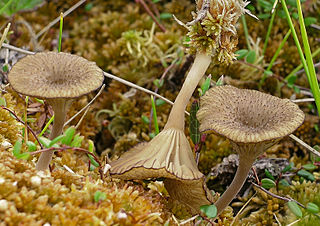
Omphalina is a genus of small agarics with white, nonamyloid, basidiospores and decurrent gills. Typically the cap has a deep central depression giving the umbrella-like to funnel-shaped cap the appearance of a belly button, or a belly with a navel. Similarly-shaped agarics are said to be omphalinoid in appearance.

Cyptotrama asprata, commonly known as the golden-scruffy collybia or spiny woodknight is a saprobic species of mushroom in the family Physalacriaceae. Widely distributed in tropical regions of the world, it is characterized by the bright orange to yellow cap that in young specimens is covered with tufts of fibrils resembling small spikes. This fungus has had a varied taxonomical history, having been placed in fourteen genera before finally settling in Cyptotrama. This species is differentiated from several other similar members of genus Cyptotrama by variations in cap color, and spore size and shape.
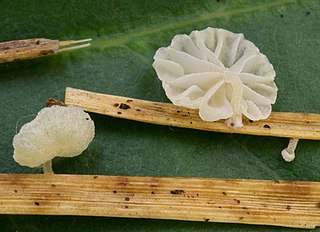
Resinomycena is a genus of fungi in the mushroom family Mycenaceae. The genus contains at least eight species found in North America, Europe and eastern Asia. This genus of small white to tan colored agarics is saprophytic and colonizes leaf litter, bark, small twigs and decaying monocot vegetation. The fruitbodies are small and resemble Mycena or Marasmius or Hemimycena and are distinguished by amyloid spores, poorly dextrinoid tissues, and the abundant oily, resinous cystidia on the pileus, lamellae edges and stipes. One recently described species, Resinomycena fulgens from Japan that is a synonym of Resinomycena japonica, has luminescent fruitbodies.

Muscinupta is a fungal genus that produces small white delicate fan-shaped to cupulate fruitbodies on mosses. It is monotypic, containing the single species Muscinupta laevis. The type species is better known under the name Cyphellostereum laeve but Cyphellostereum is a basidiolichen.

Protostropharia semiglobata, commonly known as the dung roundhead, the halfglobe mushroom, or the hemispherical stropharia, is an agaric fungus of the family Strophariaceae. A common and widespread species with a cosmopolitan distribution, the fungus produces mushrooms on the dung of various wild and domesticated herbivores. The mushrooms have hemispherical straw yellow to buff-tan caps measuring 1–4 cm (0.4–1.6 in), greyish gills that become dark brown in age, and a slender, smooth stem 3–12 cm (1.2–4.7 in) long with a fragile ring.

Leccinum arenicola is a species of bolete mushroom in the family Boletaceae. Described in 1979, the fruit bodies (mushrooms) grow in sand dunes from New Brunswick south to Cape Cod.
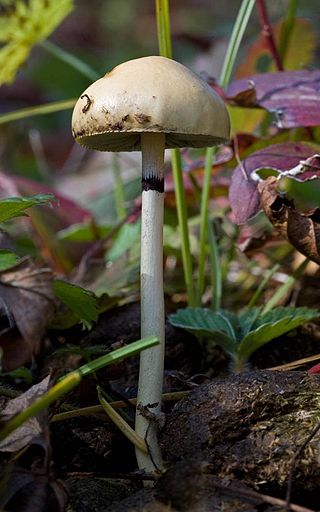
Protostropharia alcis is a species of coprophilous agaric fungus in the family Strophariaceae. The fungus produces fruit bodies on moose, elk, and deer dung. The species has been recorded in Europe, Canada and Brazil.

Saproamanita nauseosa is a species of agaric fungus in the family Amanitaceae. First described by English mycologist Elsie Maud Wakefield in 1918 as a species of Lepiota, it was named for its nauseating odor. The type specimen was found growing on soil in the Nepenthes greenhouse at Kew Gardens. Derek Reid transferred the species to Amanita in 1966, and then in 2016 the separate genus Saproamanita was created by Redhead et al. for saprophytic Amanitas and it was transferred to this new genus.
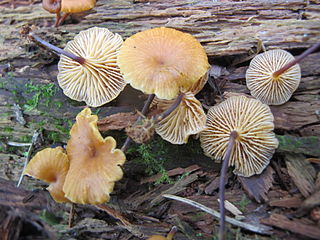
Xeromphalina cauticinalis is a species of agaric fungus in the family Mycenaceae. Originally described in 1838 by Elias Fries as Marasmius cauticinalis, it was transferred to the genus Xeromphalina by Robert Kühner and René Maire in 1934. It is found in North America, where it fruits in the summer and autumn singly or in groups on the seeds, needles, and sticks of conifers, and sometimes on aspen leaves. The fruit bodies have convex yellowish caps measuring 0.5–2.5 cm (0.2–1.0 in) in diameter supported by a tough yellow-brown to dark brown stipe that is 3–8 cm (1.2–3.1 in) long by 1–2.5 mm thick. The pale yellow gills have a decurrent attachment to the stipe and are somewhat distantly spaced. The spore print is white, while individual spores are elliptical, smooth, amyloid, and measure 4–7 by 2.5–3.5 μm.

Xeromphalina brunneola is a species of agaric fungus in the family Mycenaceae. Found in the western United States where it grows in dense clusters on debarked conifer logs, it was described by mycologist Orson K. Miller in 1968. The type collection was made by Miller near Priest River, Idaho, in September 1964. The mushroom has a dull orange, convex to nearly flattened cap measuring 0.6–15 mm (0.02–0.59 in) in diameter. The orange-buff gills are narrow, closely spaced, and decurrently attached to the stipe. Spores are elliptical, smooth, amyloid, and measure 5.5–6.6 by 2.5–3.0 μm.

Xeromphalina cornui is a species of agaric fungus in the family Mycenaceae. It was originally described in 1866 by French mycologist Lucien Quélet as Omphalia cornui; Swiss naturalist Jules Favre transferred it to Xeromphalina in 1936.
Xeromphalina junipericola is a species of agaric fungus in the family Mycenaceae. Found in Juniperus thurifera forests of Spain, it was described as new to science in 1996. The fruit bodies have purplish to violaceous tinged caps measuring 0.2–0.6 cm in diameter. It has smooth, amyloid, and hyaline (translucent) spores measuring 3–4 by 2–2.5 μm.
Xeromphalina cirris is a species of agaric fungus in the family Mycenaceae. Described as new to science in 1988, it is known from montane or boreal coniferous forests floors in British Columbia, Ontario, Colorado, Idaho, New Mexico, Oregon, Utah, Washington, and Wyoming.
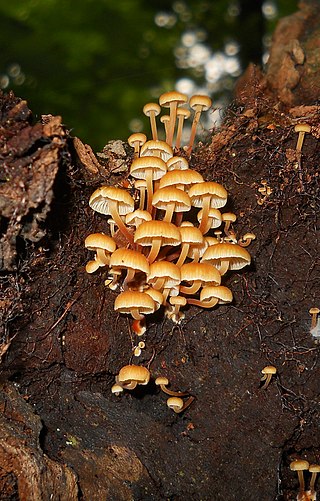
Xeromphalina kauffmanii is a species of agaric fungus in the family Mycenaceae. Found in North America, Costa Rica, and Japan, it was described as new to science in 1953. The type collection was made in Chelsea, Michigan, in June 1940. The specific epithet kauffmanii honors American mycologist Calvin Henry Kauffman.













